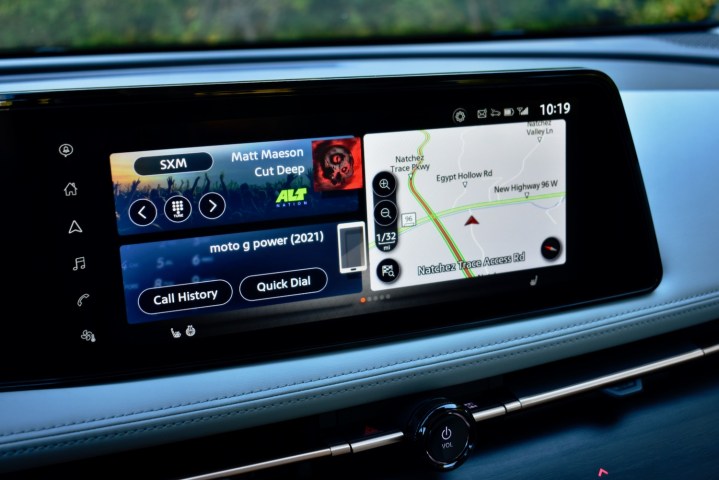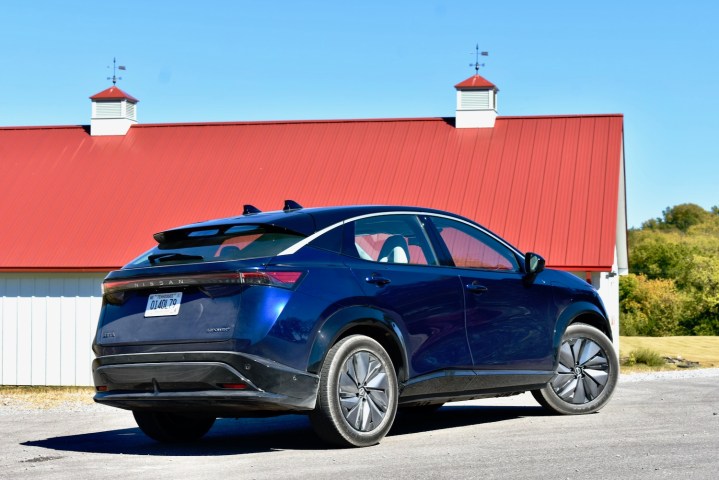Nissan played an understated role in the modern era of electric cars. While Tesla gets most of the attention, the Nissan Leaf became the first modern mass-market EV when it launched in December 2010. But Nissan has squandered that early lead. The Leaf remains a decent car, but Nissan needed to follow it up with another model, specifically an SUV, that would appeal to more car shoppers. That’s where the 2023 Nissan Ariya comes in.
The Ariya is the long-awaited sequel to the Leaf, boosting updated tech, better performance, and an SUV body style to match current trends. But during the Ariya’s long gestation (it was originally supposed to launch in 2021), other automakers have come up with electric SUVs of their own. So while it was once a leader, Nissan must now follow the Ford Mustang Mach-E, Hyundai Ioniq 5, and Kia EV6, among others.
Pricing starts at $44,485 (with destination) for the base Ariya Engage trim level with front-wheel drive and the smaller 65-kilowatt-hour (63-kWh usable capacity) battery pack. Pricing rises to $61,485 for the top Platinum+ model with all-wheel drive and a 91-kWh (87-kWh usable capacity) pack, but all-wheel drive models won’t arrive until after the front-wheel drive models. Nissan hasn’t discussed plans to assemble the Ariya in the U.S., so it likely won’t qualify for the revised federal EV tax credit.
Design and interior
If it had launched even two years ago, the Ariya would have looked cutting-edge. Its rounded exterior surfaces make a nod to aerodynamics while still preserving the SUV look buyers love. It’s a nice-looking vehicle too, but so are the Ford Mustang Mach-E, Hyundai Ioniq 5, and Kia EV6, all of which have gone on sale since the Ariya was announced in 2020. Nissan is no longer a trendsetter, but the Ariya can at least claim a more SUV-like feel than those other EVs, in both its tall profile and high-and-mighty driving position.
More significant than the styling, though, is that the Ariya rides on a new EV-specific platform. In contrast to the Leaf, which shares some of its structure with gasoline cars, engineers could take full advantage of the efficiencies of an electric powertrain and maximize interior space. Like certain other automakers, Nissan also opted out of a frunk in order to maximize passenger space, moving components like the air conditioner under the hood to make more room in the cabin.
Rounded surfaces nod to aerodynamics while still preserving the SUV look buyers love.
Nissan’s focus on interior space and the Ariya’s traditional SUV shape don’t yield more interior space than similarly priced EVs, though. The Hyundai Ioniq 5 — which draws its styling inspiration from a 1970s economy car — actually has more front headroom and rear legroom. The Ariya’s 22.8 cubic feet of cargo space with the rear seats up and 59.7 cubic feet with the rear seats folded aren’t best-in-class either. The Ford Mustang Mach-E, for example, has nearly 7.0 cubic feet more with its back seats up.
However, Nissan redeems itself with some clever interior touches, including a powered center console that can slide fore and aft, and a power-opening storage compartment that’s perfect for stashing phones. We liked the interior design as well; haptic controls embedded in wood trim and ambient lighting inspired by Japanese lanterns give it a distinctive appearance.
Tech, infotainment, and driver assist
Nissan doesn’t skimp on infotainment tech. The Ariya comes standard with a 12.3-inch touchscreen infotainment system and 12.3-inch digital instrument cluster, along with Apple CarPlay and Android Auto connectivity (wireless for CarPlay, wired for Android Auto) and a built-in Wi-Fi hots pot. Amazon Alexa connectivity and four USB ports (one Type-C and Type-A for each row) are standard as well, while a head-up display is available on most models.
The infotainment system was easy to use, thanks in part to a natural-language voice recognition system that responds to the prompt “Hey Nissan” and understands casual speech like “turn the temperature down.” But the graphics on both the touchscreen and instrument cluster seemed dated, almost like Nissan recycled them from older models. Everything also seemed crammed in; the touchscreen tiles for radio station, map, and phone made for an unappealing collage, and the instrument cluster’s display seemed disorganized.
A long list of driver aids are standard under the Nissan Safety Shield 360 banner, including forward collision warning, automatic emergency braking, blind spot monitoring, rear cross traffic alert, lane departure warning, automatic high beams, and rear automatic braking.
Nissan doesn’t skimp on infotainment tech.
The Ariya is also available with ProPilot Assist 2.0, the latest version of Nissan’s highway driver-assist system. Unlike the original version, ProPilot Assist 2.0 is a hands-free system that can control steering, acceleration, and braking for sustained periods, as well as change lanes. Drivers still have to keep their eyes on the road, however, and a camera checks for that. ProPilot Assist 2.0 also works only on pre-mapped stretches of divided highway (Nissan claims more than 200,000 miles are currently compatible). With its hands-free capability, driver monitoring, and reliance on maps, ProPilot Assist 2.0 is similar in concept to General Motors’ Super Cruise and Ford’s BlueCruise systems.
We only had a brief experience on mostly straight stretches of highway with little traffic, but ProPilot Assist 2.0 impressed. The experience was similar to that of Super Cruise, with mostly smooth control inputs, although Nissan requires drivers to keep their hands on the wheel during automatically executed lane changes. We also like Nissan’s use of colored lighting to tell the driver what’s going on. The interior ambient lighting, instrument cluster display, and head-up display (if equipped) will go blue when hands-free driving is active and white when the system is on, but not engaged. The system can also step down to hands-on mode, signified by green lighting.
The Ariya also marks the U.S. debut of ProPilot Park, Nissan’s automated parking system. It can do just about everything involved in parking, controlling acceleration, braking, steering, and forward and reverse shifting, but some competitor brands already offer similar capability. The Hyundai Ioniq 5’s Remote Smart Parking Assist doesn’t even require you to be in the car. Nissan’s system is also very conservative in terms of speed and the amount of space left in front and back of the car when parallel parking, so it’s unclear how practical it will be in the real world.
Driving experience
A single electric motor is standard, sending 214 horsepower and 221 pound-feet of torque in the base Ariya Engage model with the 65-kWh battery pack. Models with the larger pack are rated at 238 hp, with the same torque output. Models with Nissan’s new dual-motor all-wheel drive powertrain, dubbed e-4orce, will start shipping a few months after the front-wheel drive models. Final specs for the e-4orce powertrain will be revealed closer to that time.
Our front-wheel drive test car provided the typical EV acceleration experience. We could leave just about everything behind off the line. Because of this, the Ariya will feel like a sports car to anyone coming from a traditional gasoline compact SUV like Nissan’s own Rogue. That thrust drops off pretty quickly, but not before the Ariya reaches highway speeds. After this experience, we’re definitely eager to try the e-4orce all-wheel drive powertrain.
Overall, the feeling was that of stability, not agility.
While not sporty, the Ariya felt impressively composed in corners. While there was some body roll, the Ariya turned in nicely, without the tendency to plow ahead, known as understeer, that’s endemic in front-wheel drive cars. It also had a very comfortable ride with no jiggling over bumps. But the steering felt very loose and imprecise, which made the Ariya itself seem larger and more ungainly than it was. Overall, the feeling was that of stability, not agility.
The Ariya also gets a new regenerative-braking control system called e-Step, instead of the e-Pedal system used in the Leaf. Where e-Pedal blends regenerative and friction braking to allow for true one-pedal driving — including bringing the car to a full stop in some situations — e-Step allows the car to creep forward like a gasoline vehicle and, in our experience, generally dials back the aggressiveness of regeneration. This was a conscious choice in response to customer feedback, Nissan representatives told Digital Trends, adding that the more familiar driving experience afforded by e-Step is in keeping with the Ariya’s mission of mass appeal.
Range, charging, and safety
Official range ratings haven’t been confirmed yet, but Nissan expects a maximum 304-mile range for the front-wheel drive Venture+ model, 216 miles for the base Engage model with the smaller battery pack, and 289 miles for all other versions.
The Ariya can DC fast charge at up to 130 kilowatts, allowing for a 20% to 80% charge in 35 minutes with the smaller battery pack and in 40 minutes with the larger pack. Instead of the CHAdeMO connector used by the Leaf, the Ariya also has the more common Combined Charging Standard (CCS) connector.
If you decide to Level 2 AC charge at home, the Ariya’s 7.2-kW onboard charger can fully recharge the smaller pack in 10.5 hours, while the larger pack takes 14 hours.
The Ariya gets a three-year, 36,000-mile limited warranty and eight-year, 100,000-mile battery warranty. Those are pretty standard warranty terms. No crash-test ratings are available as the Ariya is a new model.
How DT would configure this car
Looking at the currently available front-wheel drive models, it’s impressive that even the base Ariya Engage trim levels gets the 12.3-inch touchscreen and instrument cluster, as well as most driver aids, as standard equipment. But you’ll have to upgrade to the Empower+ to get ProPilot Assist 2.0 and ProPilot Park. Those models also get the larger battery pack, which we would have added to our ideal build in any case. We don’t see a point in upgrading from the Empower+ to the top Premiere model, as the tech features carry over.
That leaves us with an electric SUV that’s nice to drive, fairly spacious, loaded with tech, and has an estimated 289-mile range, all at a base price of $54,985. The specs of our ideal Ariya would look competitive against the Volkswagen ID.4, an entry-level EV that extracts up to 275 miles of range from an 82-kWh battery pack. But the pricing puts the Ariya in competition with the aforementioned Ford Mustang Mach-E, Hyundai Ioniq 5, and Kia EV6.
As nice as the Ariya is, we can’t see why it costs this much. It lacks the sporty driving dynamics of the EV6 and Mach-E, and the latter has its own hands-free driving system in the form of BlueCruise. So does the Super Cruise-equipped Chevrolet Bolt EUV, which is priced well below the Ariya, for that matter. And while the Ariya has an appealing design, so does the retro-modern Ioniq 5.
The Ariya is a great new entry to the EV market, but despite its charming design and array of tech features, it’s a poor value. Perhaps the upcoming all-wheel drive version will change that, but for now the Ariya shows that Nissan has made up ground but hasn’t retaken the lead.







